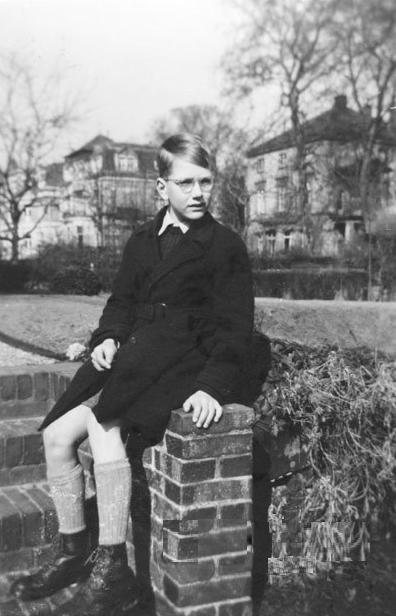
German Boys Footwear: High-top Shoes

Figure 1.--Here we see a German boy during World War II wearing high-top shoes. He looks to be about 12-years old and lives in what looks like a well-to-do neighborhood. High-tops were still common for school age boys, although we do not see teenagers wearing them. Leather was a critical material for the Germans as horses were wifely used for military transport. After 1941 shoes became increasingly hard to get in Germany.
|
|
Our information on high-top shoes in Germany is still quite limited, primarily because our 19th century archive is not yet very large, We begin to see high-top shoes in America after the Civil War (1861-65). We suspect that the time line in Germany is similar, in p[art because of technological developments. High-tops became the dominant shoe style in America, not only for boys and girls, but for adult men and women as well. We know that hightops were being widely worn in Germany by the 1870s. But we are not sure that they were as pervasive as in America. This needes to be confirmed. We continue to see high-tops intop the early-20th century, a [eriod for whuich we jhave mnore information. We seem to find a greater variety of footwear in Germany than in America. The appearsmce of high-tops after the mid-19th century seems to have been a fashion development. By the early-20th century we begin to see high-tops being marketed as more healthy for children because of the support they offered. A good example here is two unidentified younger brothers in 1925. We are not sure if the same occurred in Germany as we have less access to marketing literature and catalogs. We note, hoever that German mothers choosing fotwear for children that did not offer support like strap shoes and sandals. These styles seem more popular in Germany than America. We assume seasonal factors were at play here meaning that German children might have both strap shoes/sandals and high-top shoes which were worn seasonally. We are not sure about social-class factors. Here we see a boy from an affluent neighborhood wearing high-tops in 1941 (figure 1).
There seem to have been less gender differences than in America. Agter World War I, high-top shoes continued to be worn by German boys, but gradually declined in popularity. They seem to have over time become primarily a boys's style. We continue to see them after World War II into the late-40s. We assume they were still worn in the early-50s, but we have not yet found examples.
Chronology
Our information on high-top shoes in Germany is still quite limited, primarily because our 19th century archive is not yet very large, We begin to see high-top shoes in America after the Civil War (1861-65). We suspect that the time line in Germany is similar, in p[art because of technological developments. High-tops became the dominant shoe style in America, not only for boys and girls, but for adult men and women as well. We know that hightops were being widely worn in Germany by the 1870s. But we are not sure that they were as pervasive as in America. This needes to be confirmed. We continue to see high-tops intop the early-20th century, a [eriod for whuich we jhave mnore information. We seem to find a greater variety of footwear in Germany than in America. The appearsmce of high-tops after the mid-19th century seems to have been a fashion development. By the early-20th century we begin to see high-tops being marketed as more healthy for children because of the support they offered. A good example here is two unidentified younger brothers in 1925. We are not sure if the same occurred in Germany as we have less access to marketing literature and catalogs. We continue to see them after World War II into the late-40s. We assume they were still worn in the early-50s, but we have not yet found examples.
Age
Utility
We note, hoever that German mothers choosing fotwear for children that did not offer support like strap shoes and sandals. These styles seem more popular in Germany than America. We believe that high-top shoes first appeared as a fashion matter, but in the 20th cntury, orthepedists began recommending them for younger children. Interestingly at the same time, Soviet authorities were recommending that children go barefoot in the summer, at least outside of the major ciries. Often thee shoes for younger children were white. This was bot nearly as common as in Ameruica. We also see a few chuldren wearing stylish two tone high tops. A good example is Paul Clemens in 1935.
Seasonality
We assume seasonal factors were at play here meaning that German children might have both strap shoes/sandals and high-top shoes which were worn seasonally.
Social Class
We are not sure about social-class factors. Here we see a boy from an affluent neigborhood wearing high-tops in 1941 (figure 1).
Gender
There seem to have been less gender differences than in America. After World War I, high-top shoes continued to be worn by German boys, but gradually declined in popularity. They seem to have over time become primarily a boys's style.
HBC

Navigate the Boys' Historical Clothing German pages:
[Main German footwear type page]
[Main German footwear page]
[German art]
[German catalogs]
[German choirs]
[German movies]
[German royalty]
[German school uniforms]
[German youth groups]
[German sailor suits]
[Lederhosen]
[Ethnic]
[Tights]
[Long stockings]
Navigate the Boys' Historical Clothing Web Site:
[Introduction]
[Activities]
[Biographies]
[Chronology]
[Clothing styles]
[Countries]
[Bibliographies]
[Contributions]
[FAQs]
[Glossary]
[Images]
[Links]
[Registration]
[Tools]
[Boys' Clothing Home]
Created: 12:43 AM 8/18/2013
Last updated: 12:52 AM 12/29/2013



